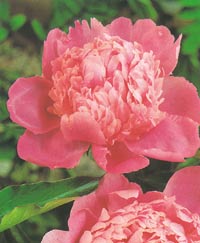 Perennials are hardy flowers known for their variety of colors, blooming times and bloom styles. Unlike annuals, perennials last for several years. Most have fleshy stems and foliage that are killed by cold temperatures or summer heat. Their roots survive, though, which allows the plant to repeat its growth cycle year after year.
Perennials are hardy flowers known for their variety of colors, blooming times and bloom styles. Unlike annuals, perennials last for several years. Most have fleshy stems and foliage that are killed by cold temperatures or summer heat. Their roots survive, though, which allows the plant to repeat its growth cycle year after year.
A well-planned perennial garden can paint your property like a rainbow. By using colors and combinations of plants, you can brighten your yard with tones and textures that also reflect your tastes. Creative concepts include mixing perennials with annuals and shrubs that overlap into different seasons and fill gaps between blooms so your yard is constantly evolving.
Think of it as painting or decorating a room – just bring your flair for color and texture combinations outside. Simply put, perennials help bring your landscape to life, especially if they draw butterflies, hummingbirds and other interesting wildlife.
One rule of thumb is to follow very few rules. Be creative and do your own thing. A perennial garden is nourished by your tastes in color and arrangement. The results can be as simple or complex as you want it to be.
Besides providing color, perennials create good ground cover, too. Many varieties are hardy plants that have a habit of spreading. But when planting, be aware that these types of perennials can cause headaches if they mix with other plants in your garden or your yard.
While you can enjoy the colors and be creative with them, don’t go overboard. Horticulturist Barbara Wilde suggests planting at least three of any single variety of perennial. And plant them in interlocking drifts – not in lines. ‘Otherwise it can look like chaos,’ she says.
But the point of perennials is enjoying them, especially when it comes to their colors. Wilde says certain colors definitely work well together, but gardeners should try new ideas and have fun with them. ‘A lot of people get distressed about color,’ Wilde says. ‘Ultimately it’s their garden, and if it looks good to them, that’s what counts.’
To make a small yard look larger, plant drifts of pastel perennials. Bright colors appear much closer and create the illusion of nearness, while the pastels tend to ‘push away’ the yard’s image. Also, you can use silvers or grays to help separate sections of various colors. And try to use a neutral color like blue when you can. Most colors tend to look good next to blue.
‘Every garden is in a constant mode of change,’ Wilde says. ‘It doesn’t matter how much experience you have. Every gardener can always improve.’
Quick Tips for Perennials
- Many people buy plants in the spring and only buy plants in bloom. That leaves their gardens without coverage in the fall or winter. To extend growth coverage throughout the year, buy plants that aren’t flowering at the moment but will bloom in July, August and September. Also, consider buying and planting perennials that are evergreens, such as the Lenten Rose (which is not really a rose) and certain types of geraniums.
- Don’t clear cut the garden in the fall when the flowers are finished for the year. Horticulturists recommend leaving the dry skeleton behind for a number of reasons, especially because it can help insulate the top of the plant buds, which sit at soil level.
- Deep, infrequent watering is best done throughout the day, starting in mid-morning and ending early enough so plants dry off before evening. Wet plants combined with cool night temperatures can foster disease development.
For home improvement advice, visit JS West Lumber & Ace Hardware Sonora, Ca. or visit www.acehardware.com and click on the Answers@Ace icon. Answers@Ace is an online resource with information for do-it-yourselfers about hardware and home improvement projects. The Everyday Projects section has pictures and detailed, step-by-step instructions for this and many more home improvement projects.
To speak to an Ace Hardware advisor in Sonora call: 209 532 7446.
